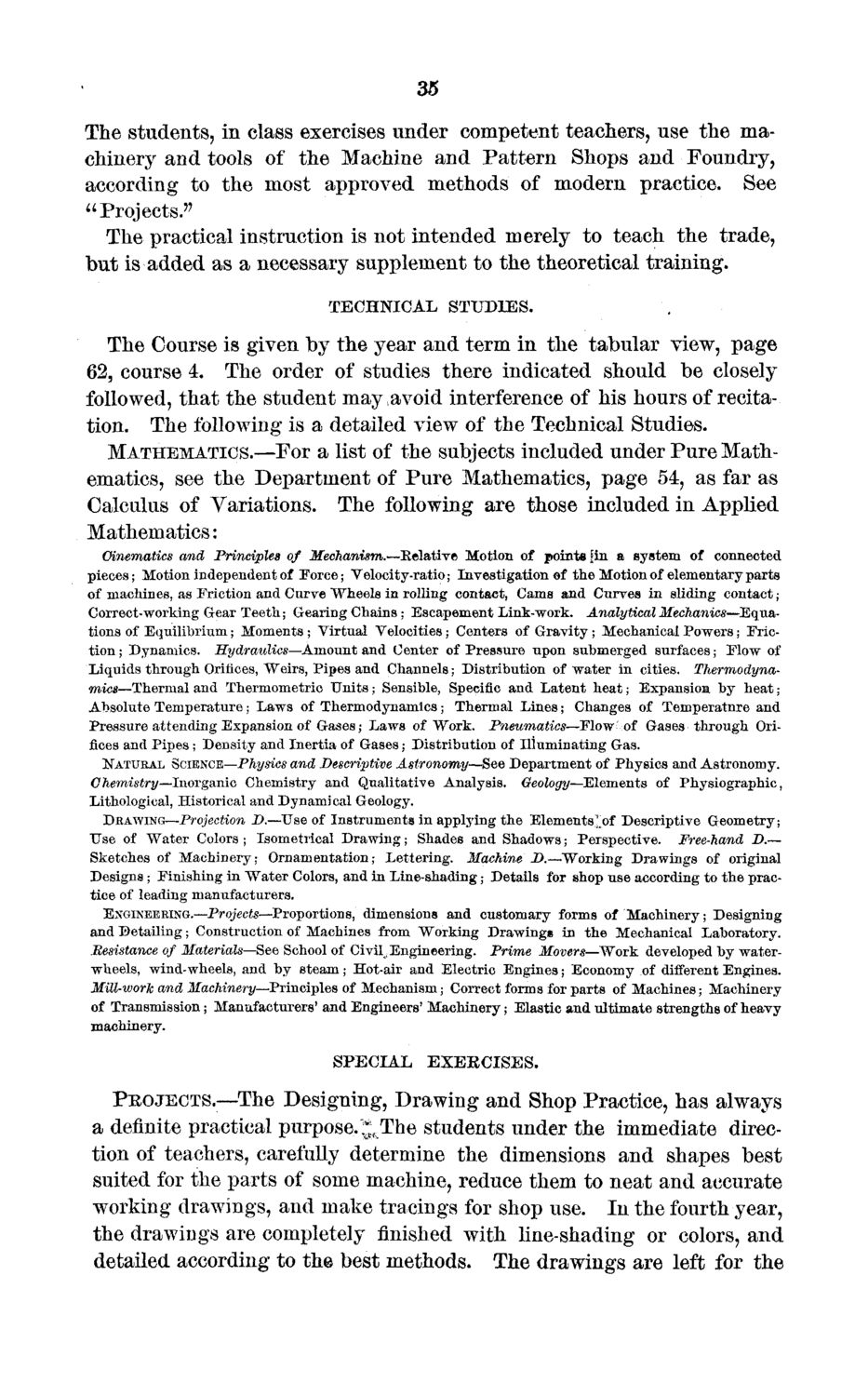| |
| |
Caption: Board of Trustees Minutes - 1873
This is a reduced-resolution page image for fast online browsing.

EXTRACTED TEXT FROM PAGE:
35 The students, in class exercises under competent teachers, use the machinery and tools of the Machine and Pattern Shops and Foundry, according to the most approved methods of modern practice. See "Projects." The practical instruction is not intended merely to teach the trade, but is added as a necessary supplement to the theoretical training. TECHNICAL STUDIES. The Course is given by the year and term in the tabular view, page 62, course 4. The order of studies there indicated should be closely followed, that the student may avoid interference of his hours of recitation. The following is a detailed view of the Technical Studies. MATHEMATICS.—For a list of the subjects included under Pure Mathematics, see the Department of Pure Mathematics, page 54, as far as Calculus of Yariations. The following are those included in Applied Mathematics: Cinematics and Principles of Mechanism.—Relative Motion of points fin a system of connected pieces; Motion independent of Force; Velocity-ratio; Investigation of the Motion of elementary parts of machines, as Friction and Curve Wheels in rolling contact, Cams and Curves in sliding contact; Correct-working Gear Teeth; Gearing Chains; Escapement Link-work. Analytical Mechanics—Equations of Equilibrium; Moments ; Virtual Velocities; Centers of Gravity; Mechanical Powers; Friction ; Dynamics. Hydraulics—Amount and Center of Pressure upon submerged surfaces; Flow of Liquids through Orifices, Weirs, Pipes and Channels; Distribution of water in cities. Thermodynamics—Thermal and Thermometric Units; Sensible, Specific and Latent heat; Expansion by heat; Absolute Temperature; Laws of Thermodynamics; Thermal Lines; Changes of Temperatnre and Pressure attending Expansion of Gases; Laws of Work. Pneumatics—Flow of Gases through Orifices and Pipes ; Density and Inertia of Gases; Distribution of Illuminating Gas. NATURAL SCIENCE—Physics and Descriptive Astronomy—See Department of Physics and Astronomy. Chemistry—Inorganic Chemistry and Qualitative Analysis. Geology—Elements of Physiographic, Lithological, Historical and Dynamical Geology. DRAWING—Projection D.—Use of Instruments in applying the Elements:; of Descriptive Geometry; Use of Water Colors ; Isometrical Drawing; Shades and Shadows; Perspective. Free-hand D.— Sketches of Machinery; Ornamentation; Lettering. Machine D.—Working Drawings of original Designs ; Finishing in Water Colors, and in Line-shading; Details for shop use according to the practice of leading manufacturers. ENGINEERING.—Projects—Proportions, dimensions and customary forms of Machinery; Designing and Detailing; Construction of Machines from Working Drawings in the Mechanical Laboratory. Resistance of Materials—See School of Civil, Engineering. Prime Movers—Work developed by waterwheels, wind-wheels, and by steam; Hot-air and Electric Engines; Economy of different Engines. Mill-worJc and Machinery—Principles of Mechanism; Correct forms for parts of Machines; Machinery of Transmission; Manufacturers' and Engineers' Machinery; Elastic and ultimate strengths of heavy machinery. SPECIAL EXERCISES. PROJECTS.—The Designing, Drawing and Shop Practice, has always a definite practical purpose.^The students under the immediate direction of teachers, carefully determine the dimensions and shapes best suited for the parts of some machine, reduce them to neat and accurate working drawings, and make tracings for shop use. In the fourth year, the drawings are completely finished with line-shading or colors, and detailed according to the best methods. The drawings are left for the
| |